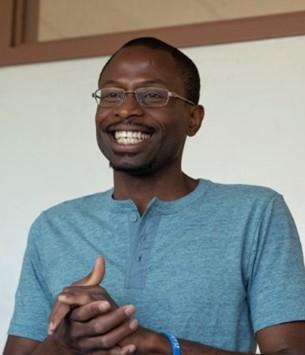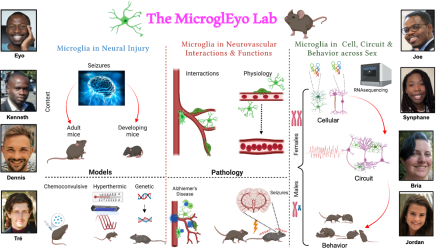
Ukpong Eyo, Ph.D
Assistant Professor of Neuroscience
Department of Neuroscience and Brain Immunology and Glia Center
University of Virginia School of Medicine
MicroglEyo Lab
Surrounding yourself with a supportive network
Pursuing a career in neuroscience was never really a choice for me. It’s almost as if neuroscience found me rather than I found her.
I was originally born in Nigeria. My mother was a teacher and, growing up, I wanted to be a teacher, too, because I’ve always enjoyed explaining concepts. However, my mother dissuaded me from this path because, as she saw it, teaching did not pay well. My second career choice was to become a doctor, so I came to the U.S. for college with the intention of going to medical school. I quickly learned that medical school was very expensive and as an international student, I realized there was no way I could afford it. That’s when an undergraduate professor suggested I consider graduate school.
I went to a small undergraduate institution, Northwest Missouri State University, and did not have any research or wet lab experiences, but with the help of my undergraduate advisor, Dr. Peter Kondrashov who now serves as Chair of the Anatomy Department at the Kirksville College of Osteopathic Medicine, I applied to graduate school. I was accepted into a doctoral program in Biology at the University of Iowa. When I initially started graduate school, I had the vision of becoming a teaching professor, but once I got a taste of research, I was absolutely captivated by it. After my third research rotation, I decided to join a neuroscience lab under the mentorship of Dr. Michael Dailey. The Dailey lab focused on studying glial cells, which ignited my interest in microglia.
As I was finishing graduate school, a new paper came out that suggested microglia had an important role in neurodevelopment. I was fascinated by this, so I decided to pursue a similar line of research as a postdoctoral fellow, first at Rutgers University and later at the Mayo Clinic in Minnesota. During my postdoctoral training, I worked in Dr. Long-Jun Wu’s lab, where I started examining microglial-neuronal communications.
My postdoctoral advisor was very intentional with my training and helped me get on a T32 training grant. It was through the T32 grant that I became aware of NIH funding and began to learn the intricacies of applying for grants. I initially applied for a K99/R00 grant, but this did not work out for me. I went to the American Epilepsy Society annual meeting to give a talk and I met an NINDS program officer who encouraged me to apply for the K22[1]. Before this meeting, I had never heard of the K22 grant mechanism before, but I still applied, and I got it! Receiving the K22 award opened up a multitude of doors for me. The year before I received funding, I applied to faculty positions and never heard back. The K22 award really gave me visibility during my job search and was a turning point in my career. I applied for faculty jobs again, received several interviews, and ultimately ended up accepting a tenure track faculty position at the University of Virginia. As a principal investigator, I have continued my research on microglia with a focus on neurodevelopment and now have two R01 grants and one R21 grant funded by NINDS.
I want to emphasize that I am where I am today because people invested in me. I’ve worked hard throughout my career, but I’ve also been incredibly fortunate to be surrounded by supportive mentors along the way. My undergraduate advisor was perceptive enough to see my potential to become a scientist and urged me to apply to graduate school. My graduate advisor introduced me to glial cells, which I’ve made the primary focus of my research today. My postdoctoral advisor encouraged me from day one to become a principal investigator of my own lab. Even when I had doubts, he pushed me to apply for grants and provided every resource I needed. He would always say I would become a faculty member in a few years and having that encouragement as a postdoc made all the difference.
Now, as the principal investigator of my own lab, I try to provide support and encouragement to all the trainees in my lab to help them succeed. I work with these trainees to teach them the necessary skills in the lab, but I also encourage them to develop skills such as communication, teamwork, management, openness and appreciation for various levels of training background and socio-culturo-racial diversity. While these skills may be harder to train formally, I believe they are crucial for success in not only academia, but any career trainees that go through my lab decide to pursue. It’s also important to have more than one mentor because different mentors can help shape different aspects of one’s career development.
My advice to others on this journey is: as you think about your career path, be brutally honest with yourself and decide on a career that will make you happy, and then actively seek out mentors that can help you achieve your goals. It’s likely you will encounter challenges and barriers to your success at some point in your career, especially for underrepresented minorities and international students, but strong mentorship can really make the difference in overcoming these obstacles.
Current Research
Research in our lab is focused on understanding microglial contributions to: (1) neural injury, (2) neuro-glio-vascular cell-cell interactions & function, and (3) sexually dimorphic cell and animal behaviors. Our research is performed with a dual focus on physiology and pathology. In physiology, we seek to understand (i) developmental mechanisms as well as (ii) mechanisms employed in maturity and believe that this can inform our understanding of aberrations that occur in pathology. The pathological contexts of our investigations include mouse models of seizure disorders, neurodevelopmental disorders, and Alzheimer’s disease. To accomplish our research goals, we employ a wide range of experimental approaches in a highly collaborative and diverse research environment. Our research approaches include in vivo and ex vivo two-photon acute, chronic and live imaging, confocal microscopy, flow cytometry, RNA sequencing, immunohistochemistry, laser speckle imaging as well as animal models of seizures and neurodegeneration. Our research is conducted by an intentionally international team of passionate scientists including several postdoctoral researchers, graduate students, laboratory technicians, undergraduate students and high school affiliates. Our team members come from different ethnic ancestries represented from four continents, have a wealth of prior training in various academic disciplines and have rich aspirations for their future careers.

[1] The NINDS K22 Award is no longer available; instead, please consider applying for the K99/R00 MOSAIC Award
